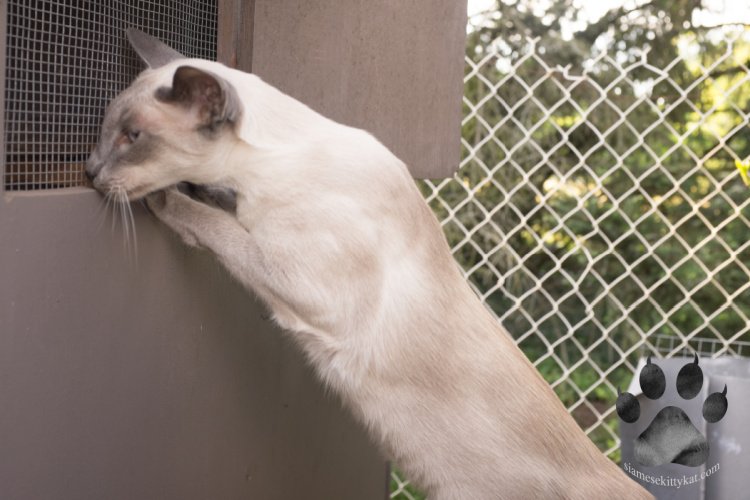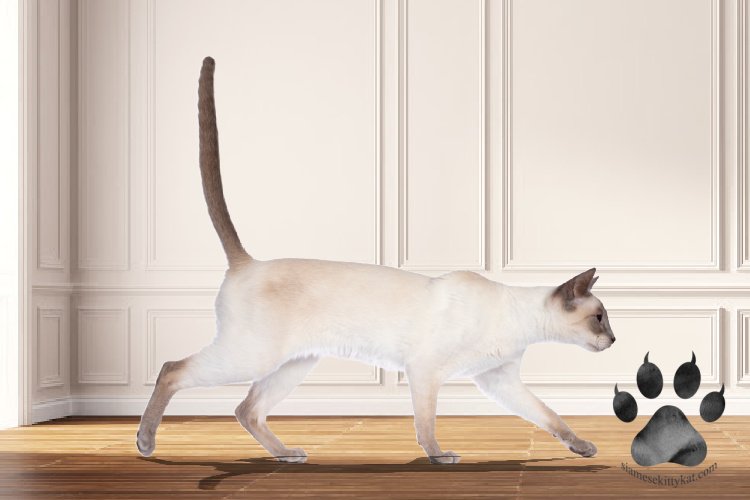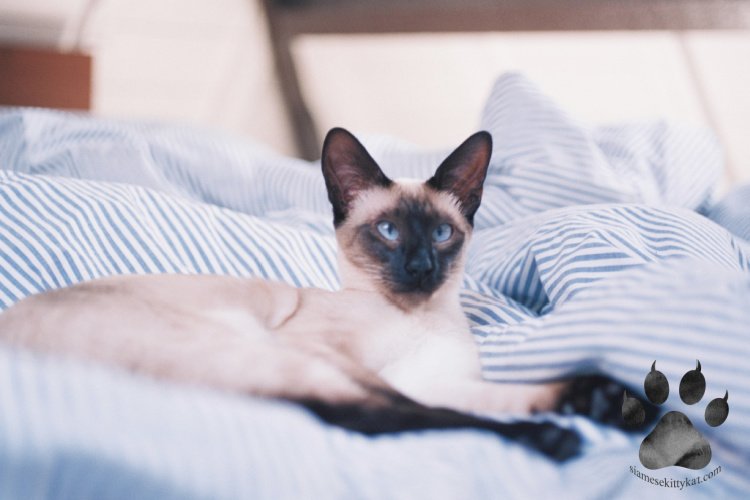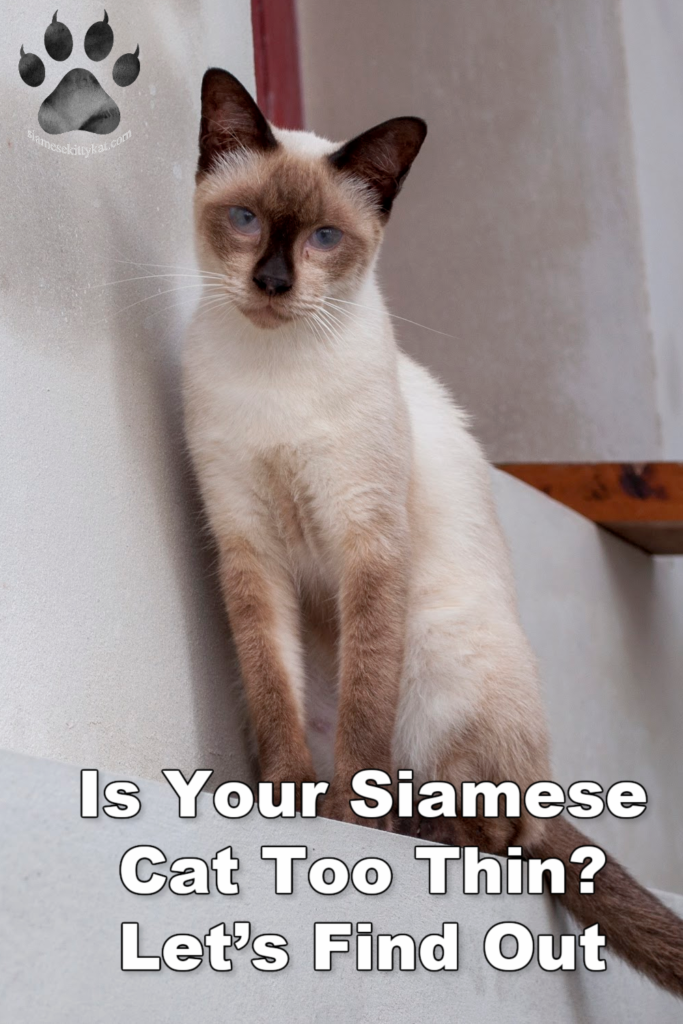Siamese cats are long and slender by nature. They often sport a very athletic type of build and look a lot smaller compared to your average moggie.
While it may be common for them to look thinner than most felines, there is a point where skinny becomes unhealthy.
As a general rule, if you can see your Siamese’s ribs poking through their skin and/or feel little to no fat covering their ribs and back, their weight is a cause for concern.
Since Siamese cats have a short coat, typically it’s hard for their weight to go unnoticed. However, if your Siamese is eating and doing well overall, it’s not uncommon for the signs to be missed.
A healthy female Siamese typically weighs around 7.7lbs – 10.6lbs, whereas a male will weigh around 9.9lbs – 12.1lbs. After your Siamese reaches the age of two, only then are they considered fully grown.
For Siamese kittens, their weight should look something like this:
Are Siamese cats naturally skinny?
It’s important to remember that all cats are different. They come in many different shapes and sizes, so determining whether or not they’re a perfect size may not be as black and white as you think.
There are two categories in which cats usually fall under:
Siamese cats are naturally built smaller than cobby builds. If your Siamese looks smaller than a Persian (even without all that fluff) you shouldn’t worry too much about it.
How do I know if my Siamese is too thin?

Since Siamese cats have a much shorter coat than most, the signs that they are underweight are usually shown within their physical appearance.
Check this guide to see which category your Siamese falls under:
Extremely Thin
Underweight
Ideal
Overweight
Obese
Of course, the best way to figure out if your Siamese is underweight is to take them for a check-up. It won’t take your vet long to determine their ideal weight and set both you and your kitty on the right path.
6 Reasons your Siamese is too thin

There are several reasons why your Siamese cat may be too thin. It could be that they’re not eating enough, or they’re using up more energy than they are initially consuming.
Rapid weight loss can also be a red flag concerning the health of your Siamese. It is usually the first sign of underlying health issues and is often accompanied by vomiting and nausea.
It could be as simple as your Siamese not receiving enough nutrients from their food. Either way, you should always check with your vet if you have concerns about your Siameses weight.
Check out the following 6 reasons your Siamese may be too thin:
1. Not Eating Enough
The most obvious reason why a cat appears too skinny is due to not eating enough. However, most of the time this is not down to underfeeding, but because of competition within the household.
My good friend – who owns two kitties of her own – recently went through this issue with her cats. This is the reason I decided to write about this particular topic, so I asked her if she could share her experience:
“I have two cats at home, one named Bert, who is around 4 years of age, and Star who is 3.
We moved house about 2 months ago into a much smaller apartment. Due to this, I moved both of their food dishes into the kitchen and made sure to feed them at the same time I always did.
For a few weeks, everything seemed fine. They were both settling in well and their food bowls were empty after every meal.
I began to notice that Star was slowly losing weight. I couldn’t put my finger on it. She was eating well, didn’t seem overly stressed, and I even took her to the vets for a check-up.
I changed her food to see if that was the problem, but still, she continued to lose weight. The vet suggested to me that maybe Bert, my older cat, was also eating her food.
At first, I thought this was impossible. I used to feed them in separate rooms before moving house, but I had seen with my own eyes Star eating her food.
However I did have to admit, 70% of the time I would feed them and leave the kitchen straight after. So, I set up a camera in the kitchen to see what happened when I left.
And that’s why I caught Bert in the act. I couldn’t believe my eyes when I saw him scoff his food then turn to Star’s bowl before she even had a chance to take a bite.
It turns out that Bert had indeed been eating most of Star’s food. Bert had always been the dominant one in the relationship, but I didn’t realize it stretched so far to dinner time.
I immediately began feeding them at different times. I would feed Bert alone, and once he had eaten, I’d close him out of the kitchen and let Star eat.
After a few weeks, she had gained her weight back and looked so much healthier!”
Sometimes, one cat may be domineering over the other, and the weaker cat isn’t able to compete. If this is happening in your household, all you have to do is either feed them in different rooms or at different times.
2. Dental Issues
Dental issues can affect cats of all ages, in fact, research shows that around half of the cats over the age of 3 suffer from various dental problems.
This can include:
If you’ve ever suffered from dental issues, I’m sure you know how painful eating can be. The last thing your Siamese will want to do is eat when their mouth hurts.
Siamese kittens can also lose appetite when they’re going through their teething phase.
To resolve any dental issues, you’ll need to get in contact with your vet. You can schedule a routine cleaning, as well as practice brushing their teeth at home.
3. Not Enough Nutrients
Cats are obligate carnivores. These types of carnivores rely on the nutrients found within animal products to survive. In the wild, your typical feline can be found consuming prey that contains high protein, moderate fat, and just 5% carbohydrates.
Even domesticated kitties need this diet in order to stay healthy. That includes a handful of nutrients, minerals, vitamins, fatty, and amino acids.
The food in which your cat is consuming will have a nutritional label. Take a look at this label to ensure your Siamese is getting all the nutrients and proteins they need for a healthy diet.
If not, your Siamese will begin to lose weight. This is their body’s attempt at extracting the nutrients they need from their body fat.
4. Gastrointestinal Obstruction
Gastrointestinal obstruction refers to an obstruction that occurs within the stomach or intestines of your Siamese. This condition prevents food from being properly digested.
Since cats are susceptible to gastrointestinal obstruction, it is fairly common. However, Siamese kittens are at higher risk of this condition as they are often chewing or putting objects that can easily be swallowed into their mouths.
Symptoms of gastrointestinal obstruction may include:
5. Parasites
Ringworm and tapeworm are just two of the many parasites that can infect your Siamese. These parasites can cause weight loss since they take the nutrients from your cat’s body as they are attempting to digest food. If left untreated, your Siamese will rapidly begin to lose weight.
Thankfully, they are easily treated using deworming medications provided to you by a veterinarian. Once treated, these parasites will begin to go away and your Siamese should start gaining weight.
6. Diabetes
Cats who suffer from diabetes have a huge appetite, yet aren’t able to keep any weight on. Diabetes affects the way your cat extracts and retains nutrients, in turn heightening their appetite.
Signs your Siamese has diabetes:
If you notice any of these signs, contact your local vet. There, they will be able to do a blood test and come up with a treatment best suited to your Siamese.
What should i feed my Siamese?

With so many options on the market, it can be difficult choosing the right one for your Siamese.
As I mentioned before, cats are obligate carnivores. Due to this, their diet should be mainly made up of protein, nutrients, and only 5% carbs. That’s why it’s always recommended against feeding your feline an all-dry food diet.
With dry food being their main source of nutrients, it’s basically impossible to accomplish a balanced diet. Commercially available dry food contains mainly carbs, fillers, and plant protein.
Just because a brand claims they provide a balanced and nutritious diet, doesn’t always mean it’s true.
Believe it or not, cats get most of their hydration via the food they eat, and not the water they drink. Wet food contains 70-80% water, where dry food contains a mere 10%. Even if your Siamese is drinking twice the amount of water, it isn’t enough to make up for the loss.
Arguably the best (and most expensive) way to feed a feline is with an all-raw diet. For this diet, your Siamese will consume meat that is raw or slightly cooked. This most resembles the diet they would consume in the wild.
However, the most common and somewhat affordable option would be a mixed wet and dry food diet. Of course, this is assuming they have no underlying health issues or dietary requirements.
It’s good to take into consideration that you get what you pay for. If you can afford the extra bucks, it’s well worth going for the more expensive option if it ensures your Siamese is getting all the nutrients they need.
How can I help my Siamese put on weight?
If your Siamese is underweight and needs to put on a few extra pounds, try the following:
NOTE: You should always consult your vet before making any drastic changes in your Siameses diet.
Switch up their diet:
Switch up their environment:
Is my Siamese healthy?
Siamese kitties are thin by nature, so it can be hard to tell when their breed qualities stop and health concerns start.
As a general rule, a male Siamese should weigh around 9.9lbs – 12.1lbs and a female 7.7lbs – 10.6lbs. If they fall even 10% under this threshold, then their weight is a cause for concern.
If your Siamese is having problems with their weight, you should always contact a vet. A check-up may reveal some underlying issues that are causing this weight loss to happen.
Always keep an eye on their diet to ensure they’re consuming the right amount of nutrients to keep them healthy, happy, and thriving.
We gathered all the health tips tailored towards maintaining your Siamese cat’s optimal well-being. Check it out here: Siamese Cat Health: A Complete Guide
Get your FREE Siamese Cat 2024 Printable Calendar


